Have you noticed that direct traffic year over year is through the roof? Maybe you scratched your head, wrinkled your brow and chalked it up to better brand recognition. In reality, no such thing happened. What is happening is search traffic from iOS is being attributed to direct traffic instead.
Your organic search numbers are being mugged.
[Update] Frank Zimper notes that this problem also exists for those running Android 4.0 and higher. I’ve confirmed this via the same process you’ll read below. The only saving grace is that Android is usually a smaller traffic driver and the version migration is far more gradual. Yet, it’ll clearly continue to syphon search traffic off over time unless Google addresses this problem.
iOS 6 Search Theft

The reason these visits are being mis-attributed is a decision by Apple to move Safari search to secure (SSL) in iOS 6. The result of this decision is that the referrer isn’t passed. In the absence of a referrer Google Analytics defaults those visits to (none) which shows up in direct traffic.
The web browser on iOS 6 switched to use SSL by default and our web servers don’t yet take that fact into account. Searching still works fine, but in some situations the HTTP referer header isn’t passed on to the destination page. We’re investigating different options to address this issue.
As Google investigates different options to address this we’re left dealing with a serious data problem. Personally, I think Google Analytics should have a message within the interface that warns people of this issue until it’s fixed.
RKG did a nice job of tracking this and showing how to estimate the hidden search traffic. But for some reason this issue doesn’t seem to be getting as much traction as it should so I wanted to demonstrate the problem and show exactly how you can fight back. Because it’s tough enough being an SEO.
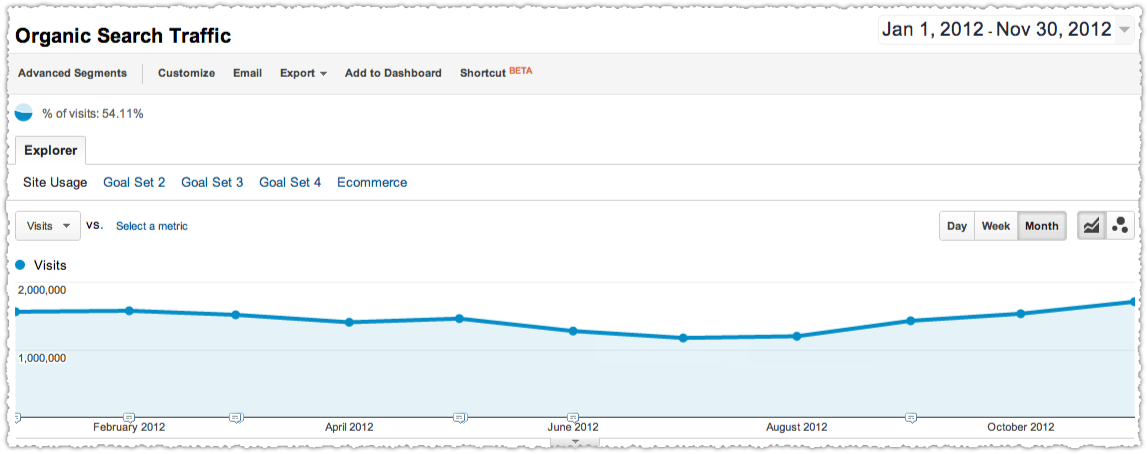
At a glance it looks like this has been a decent year for this client. But it’s actually better than it looks in October and November. Follow along to see just how much better.
Create iOS Advanced Segments
The first step is to create two Advanced Segments, one for iOS and one for iOS 6.
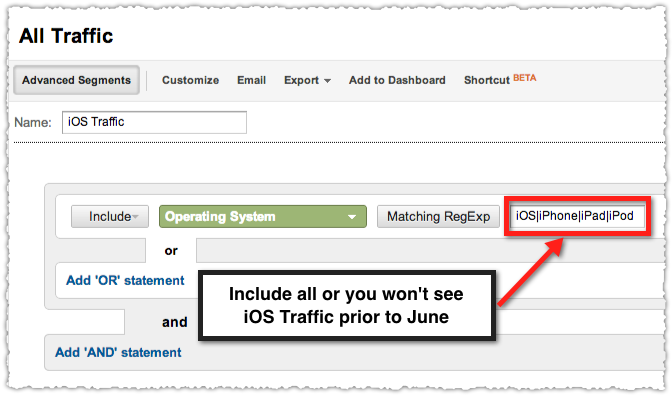
In May the labeling of Apple Operating Systems changed from specific devices to iOS. So include all four so you can see your iOS traffic for the entire year.
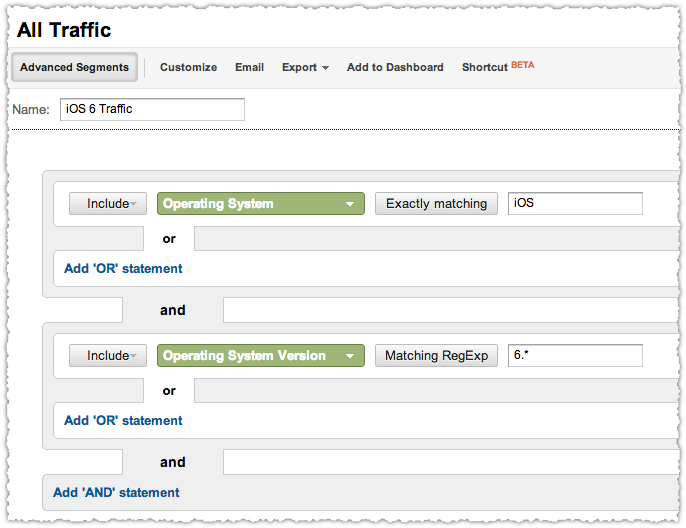
The iOS 6 segment is straightforward and will only be used to demonstrate and prove the problem. Also, if you want to perform this analysis on multiple analytics properties be sure to save these segments to any profile.
The Scene Of The Crime
Once you have your advanced segments you want to apply them as you look at direct traffic by month.
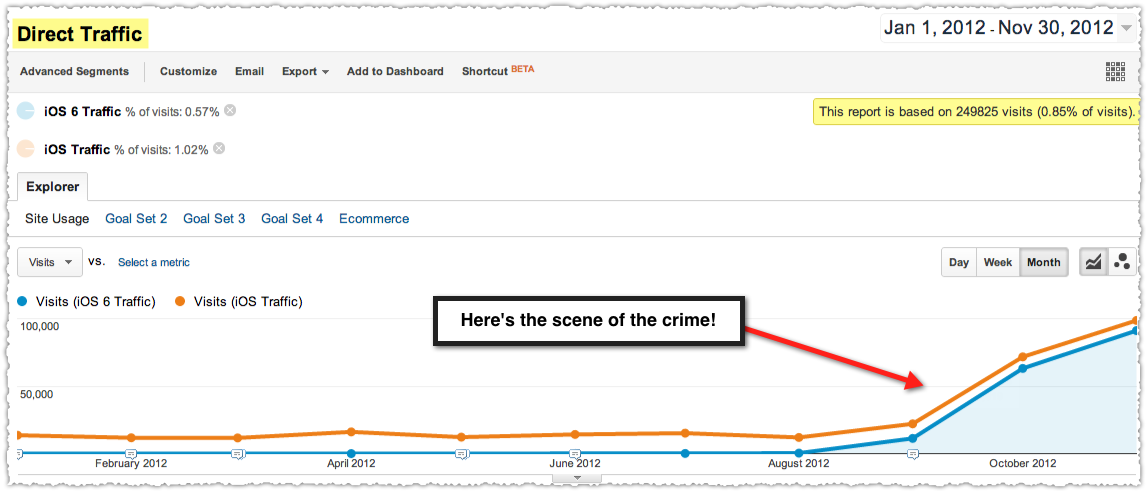
This plainly shows that direct traffic suddenly jumped from traditional levels upon the release of iOS 6 in late September.
Reclaiming Stolen Search Traffic
Every SEO should be reclaiming this stolen traffic to ensure they (and their clients) are seeing the real picture. Here’s my simple method of figuring out how much you should take back.
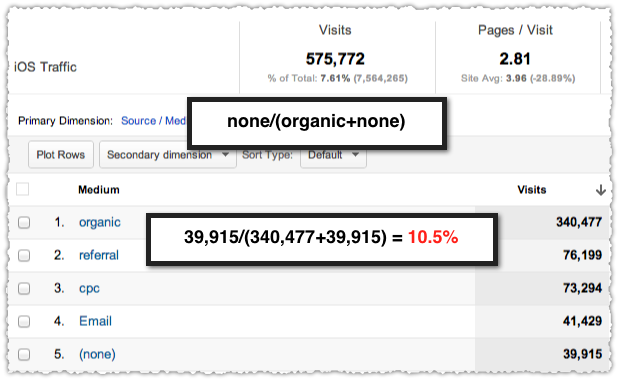
I’ve taken a three month slice of iOS traffic composed of April, May and June. From there I’m looking to see direct traffic as a percentage of the sum of direct and organic. The reason I’m not doing direct as a percentage of the total is to reduce any noise from referral spikes, paid search campaigns or other channel specific fluctuations.
In this instance direct comprises 10.5%. If you want to go the extra mile and quell the OCD demons in your head (or is that just me) you can do this for every month to ensure you’ve got the right percentage. I did and am confident that the percentage for this site is 10.5%.
Be aware, it will be different for each site.
Next I look at November and perform the same calculation just to confirm that it’s out of whack. At 46.6% it’s clearly departed from the established baseline.
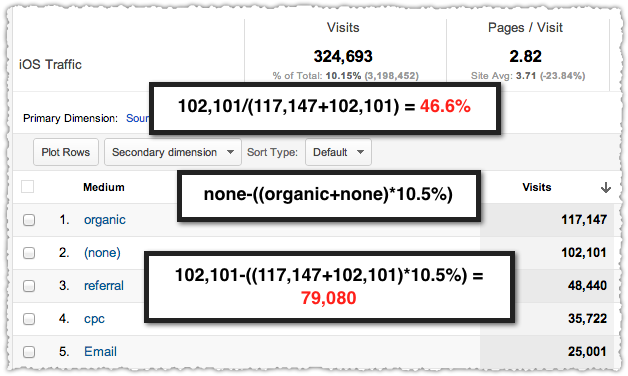
I simply apply the proper direct traffic percentage (10.5% in this case) to the sum of direct and organic traffic. That’s the real amount of direct traffic. I then subtract that from the reported direct traffic to find the lost search traffic number.
The equation is none-((organic+none)*percentage). In this case I just reclaimed 79,080 search visits!
Better SEO Results
Get the credit you deserve and apply those stolen search visits to organic traffic.
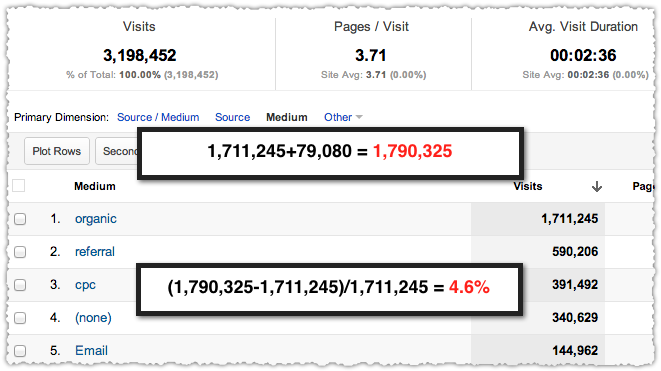
A very quick calculation shows that reclaiming iOS search traffic produced a 4.6% bump in organic traffic for this client. That’s the best 32 minutes I’ve spent in a long time. Now it’s your turn.
TL;DR
Changes in how Safari searches are passed to Google Analytics is causing organic searches to be listed under direct traffic. Give clients the real picture and get the credit you deserve by properly attributing iOS traffic.
The Next Post: 2013 Internet, SEO and Technology Predictions
The Previous Post: Twitter Will Win The Social Brand Advertising War

6 trackbacks/pingbacks
Comments About Reclaiming Lost iOS Search Traffic
// 23 comments so far.
Jason // December 19th 2012
An extra 12.5% for me, just in time for Christmas KPI’s 🙂
AJ Kohn // December 20th 2012
Nice Jason! 12.5% bump is certainly a nice Christmas gift. That’s why it’s so important to do this analysis.
James Norquay // December 19th 2012
Tested this for one property and iOS6 equates to around 15% of traffic. Very nice analysis here.
AJ Kohn // December 20th 2012
Thanks James. iOS 6 is definitely a large chunk of many sites so getting this attribution right can make a difference.
Sajeet Nair // December 19th 2012
The assumption that you are making is that the brand awareness does not increase and remains constant or is same as the previous months. The above mentioned method might not work in the event where the brand is involved in a lot of PR and off line promotion.
Nevertheless you know what they say, something is better than nothing 🙂
Thanks,
Sajeet
AJ Kohn // December 20th 2012
Thanks for your comment Sajeet. You’re right, there are a number of factors that could change the distribution including PR, offline promotion and seasonality.
The hope is that by removing the other types of traffic (email, paid search, referral) you reduce the impact of those factors. Many of those branding efforts produce direct and organic traffic, it might be in different percentages but hopefully not too much different to make the analysis invalid.
As you say though, something is better than nothing.
Steve Morgan // December 20th 2012
This is fantastic – thanks AJ!
Just did it on my company’s website and found 4.8% unaccounted for. Thought I’d share that I originally screwed up the final calculation and thought it was actually an increase in 144% – if only eh? Haha! 🙂
AJ Kohn // December 20th 2012
That’s great Steve! 4.8% bump in organic traffic? That’s a win for sure. 144% would be like winning the lottery.
Alex // December 20th 2012
You mentioned Safari browser in your post, yet somehow you are not using it in your Google Analytics settings. How come? There are people who are on iOS 6, but are browsing the next with a different browser, which IS passing the referral data via HTTP?
AJ Kohn // December 20th 2012
Alex,
I do mention Safari in the post but all of the segments created are independent of browser are are only looking at iOS or iOS 6 as an operating system.
John Wiehe // December 20th 2012
I have an organic search traffic bump of 1.8% just in time for Christmas.
AJ Kohn // December 21st 2012
That’s a nice little present under the tree John! I appreciate the comment and sharing your own personal traffic bump.
Krithika Rosenthal // December 27th 2012
Very helpful, I will be using this to see what traffic I can reclaim for my clients as well. Thank you.
AJ Kohn // December 27th 2012
Thanks Krithika. I’d love to hear what type of traffic bump you get from doing the analysis.
Christian Oliveira // January 05th 2013
Nice recap of the problem and solution!
I do the same you do but instead of get the “real” percentage from months prior to iOS 6 launch, I get it from the iOS 5 visits on the same period, because I think that the direct/organic percentage can vary a lot through time (if you are improving in SEO but direct doesn’t grow for example). We can do this at least while we have enough iOS5 visits.
Also taking one or several month of data in sites with big traffic implies that you see sampled data, so accuracy decreases.
As you say in the update it’s the same in Android, so I hope they solve this quickly
As if (not provided) were not enough 🙁
Oliver Hirst // January 15th 2013
Hi AJ –
Interesting article, however I’m in agreement with Christian Oliveira that this may not be the best formula for calculating the lost iOS 6 numbers.
I used a different formula to calculate the average percentage of direct traffic that was being contributed by iOS devices, then deducted that percentage from the affected months leaving me with a pretty close approximation of the increase due to the ‘bug’.
Obviously the formula I’m using won’t be as applicable for sites who are making use of strategies that will significantly vary their direct traffic numbers during the affected months.
The accounts I’m using this formula for are, thankfully, not using any particular tactics that would cause such deviation from the ‘norm’ (in terms of their direct traffic). So I hope that the figures I’m getting are quite realistic.
Lee Driggers // January 16th 2013
AJ,
In you’re first image after the “Reclaiming Stolen Search Traffic”, should the segment not be iOS 6.X instead of just all of iOS? This would take into account a sort of “adoption rate”.
Tyler // May 09th 2013
I’m running Android 4.1.2 and I DO see referrer information passed from my phone to my website, it reported it as Google, Organic, and (not provided) keyword.
Perhaps certain phones aren’t passing referrer information?
AJ Kohn // May 15th 2013
Tyler,
The Android world is certainly less uniform and it’s possible that some may pass referrer information, or that Google/Android may have been able to change something recently. Sadly, the amount of traffic from Android 4+ devices is small making due diligence here more difficult.
Jack Jones // June 17th 2013
Good post, I can confirm that after re-running some past reports that we have an increase in certain sectors of 20% :>
Justin // July 12th 2013
Thanks for the info! However, I am confused. When I setup the iOS-6 Traffic Advanced Segment and check out “All Traffic” in Google Analytics, I am seeing 187k organic visits last month. I would have expected to see 0 visits for organic search, considering the presumed iOS-6 issue.
D // October 25th 2013
Hi, any news about iOS7? Has Apple kept this practice moving forward with Safari?
Rob Barham // August 11th 2014
Great post!
Curious to know if this is still an issue or does GA now report Safari traffic correctly?
Sorry, comments for this entry are closed at this time.
You can follow any responses to this entry via its RSS comments feed.